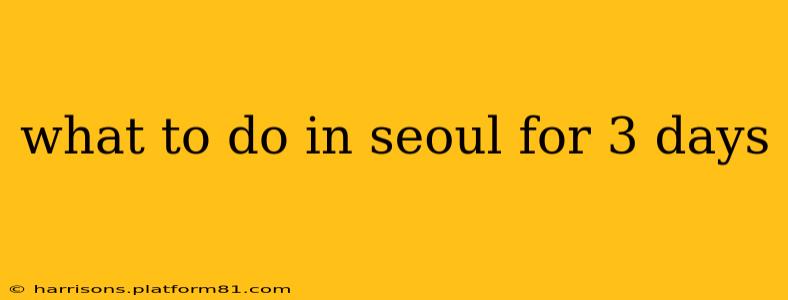Seoul, South Korea's vibrant capital, offers a captivating blend of ancient history and modern dynamism. Three days might seem short, but with careful planning, you can experience the city's highlights and create unforgettable memories. This itinerary balances iconic landmarks with hidden gems, catering to diverse interests.
Day 1: Exploring Historic Seoul & Trendy Vibes
This first day focuses on Seoul's rich history and its contemporary flair.
Morning: Begin your Seoul adventure at Gyeongbokgung Palace, the largest and most stunning of Seoul's five grand palaces. Witness the changing of the guard ceremony (check the schedule beforehand) and wander through the beautiful courtyards and ornate buildings. Afterwards, explore the charming Bukchon Hanok Village, with its traditional Korean houses, tea houses, and craft shops.
Afternoon: Immerse yourself in the vibrant culture of Insadong, known for its traditional crafts, tea houses, and art galleries. Browse through unique souvenirs, sample Korean tea, and perhaps even try your hand at calligraphy.
Evening: Experience the trendy atmosphere of Gangnam, made famous by the K-pop song. Enjoy dinner at a stylish restaurant, explore the upscale boutiques, or take a stroll along the Cheonggyecheon Stream, a beautifully restored urban oasis.
Day 2: Culture, Shopping & Panoramic Views
Today's itinerary blends cultural experiences with retail therapy and breathtaking views.
Morning: Visit the Namsan Hanok Village, a beautifully preserved collection of traditional Korean houses that offers a glimpse into the past. Afterwards, ascend N Seoul Tower, perched atop Namsan Mountain, for panoramic views of the city skyline.
Afternoon: Indulge in some serious shopping at Myeongdong, a bustling shopping district famous for its cosmetics, fashion, and street food. Sample delicious street snacks and haggle for unique souvenirs.
Evening: Enjoy a traditional Korean dinner, perhaps including bibimbap or bulgogi. Consider attending a non-verbal performance like Nanta, a high-energy percussion show.
Day 3: Temples, History & Modern Art
The final day provides a balanced mix of serene temples, historical sites, and contemporary art.
Morning: Visit Jogyesa Temple, the main temple of the Jogye Order of Korean Buddhism, and experience the peaceful atmosphere. Explore the intricate architecture and admire the serene surroundings.
Afternoon: Delve into the history of the War Memorial of Korea, offering insights into the Korean War and its impact. Afterwards, visit the Leeum, Samsung Museum of Art, showcasing both traditional Korean art and contemporary works.
Evening: Enjoy a final Korean dinner, perhaps trying Korean BBQ, and reflect on your incredible Seoul adventure. Consider a final stroll along the Han River, enjoying the city lights.
Frequently Asked Questions (FAQs)
How much time should I spend at each location?
The time you spend at each location depends on your interests. Allow at least 2-3 hours for Gyeongbokgung Palace, and 1-2 hours for each of the other major attractions. You can spend more or less time depending on your preferences.
What's the best way to get around Seoul?
Seoul has an excellent public transportation system, including subways and buses. Purchasing a T-money card is recommended for easy and convenient travel. Taxis are also readily available.
Where can I find affordable accommodation in Seoul?
Seoul offers various accommodation options, from budget-friendly guesthouses to luxury hotels. Areas like Hongdae and Myeongdong offer numerous affordable choices.
What are some must-try Korean foods?
Korean cuisine is incredibly diverse! Must-tries include Kimchi, Bibimbap, Bulgogi, Korean BBQ, Japchae, and Tteokbokki.
Is it easy to navigate Seoul?
Seoul is a very walkable city, especially within specific districts. However, the subway system is efficient for traveling longer distances. Many signs are in English, making navigation relatively straightforward.
What is the best time to visit Seoul?
Spring (April-May) and autumn (September-October) offer pleasant weather, making them ideal times to visit. Summer (June-August) can be hot and humid, while winter (November-March) is cold.
This itinerary is just a suggestion; feel free to customize it based on your preferences and interests. Remember to wear comfortable shoes, as you'll be doing a lot of walking! Enjoy your unforgettable trip to Seoul!
